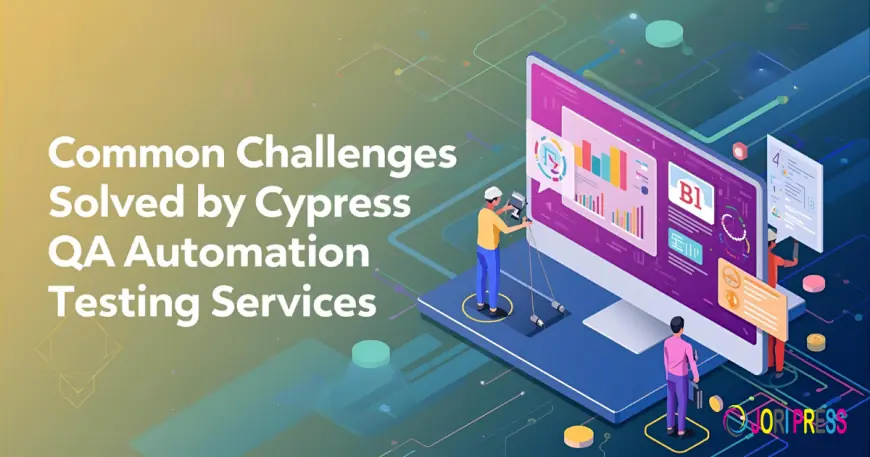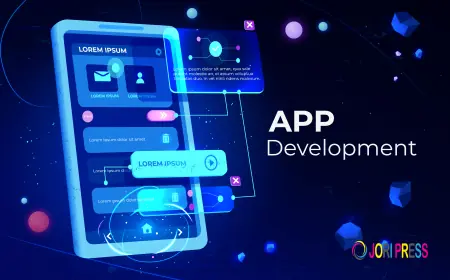Common Challenges Solved by Cypress QA Automation Testing Services

In the fast-paced world of web development, delivering high-quality software is critical. Traditional testing methods are often slow, unreliable, and resource-intensive, which can cause delays, bugs, and poor user experience. Cypress QA Automation Testing Services have emerged as a modern solution to overcome these challenges. This article explores the common challenges faced in QA testing and explains how Cypress helps solve them effectively.
Cypress is a next-generation JavaScript-based testing framework designed for end-to-end, integration, and unit testing of modern web applications. Unlike traditional tools like Selenium, Cypress runs directly in the browser, giving it full access to the application under test. This approach allows real-time test execution, faster feedback loops, and robust debugging capabilities, making it a favorite among developers and QA professionals.
By leveraging Cypress QA Automation Testing Services, companies can increase testing accuracy, improve software reliability, and speed up release cycles.
Challenge 1: Flaky and Unreliable Tests
The Problem: Flaky tests are those that pass or fail inconsistently without changes to the underlying code. They are often caused by timing issues, asynchronous code, or unstable DOM elements. These unreliable tests waste QA resources, delay releases, and create frustration for developers.
How Cypress Solves It:
-
Automatic Waiting: Cypress automatically waits for DOM elements to load and become interactable, reducing failures caused by timing issues.
-
Command Retry Mechanism: Cypress retries commands and assertions until they succeed or time out, ensuring more consistent results.
-
Real-Time DOM Access: Cypress runs directly in the browser, interacting with the real DOM rather than a simulated environment, which reduces test flakiness.
Result: Tests become more predictable and reliable, boosting confidence in the software and reducing wasted QA effort.
Challenge 2: Slow Testing Processes
The Problem: Traditional testing frameworks often require a lot of setup and slow execution. Running a full suite of tests can take hours, delaying feedback to developers and slowing down the development pipeline.
How Cypress Solves It:
-
In-Browser Execution: Tests run directly in the browser, eliminating extra layers that slow down execution.
-
Parallelization Support: Cypress supports parallel test execution, which distributes tests across multiple machines or containers for faster completion.
-
Interactive Test Runner: Developers can see tests running in real time, speeding up debugging and reducing the back-and-forth between development and QA teams.
Result: Faster testing cycles allow teams to catch bugs early, reduce development bottlenecks, and accelerate the overall release process.
Challenge 3: Complex Test Setup and Maintenance
The Problem: Setting up test environments, configuring dependencies, and maintaining test scripts is often tedious. Tests may break frequently due to changes in the UI or backend APIs, leading to high maintenance costs.
How Cypress Solves It:
-
Minimal Configuration: Cypress requires little setup to start writing and running tests. The default configuration works out of the box for most applications.
-
Intuitive API: The simple and consistent syntax makes writing and maintaining tests easier, even for less experienced QA engineers.
-
Mocking and Stubbing: Cypress allows mocking network requests and simulating server responses, reducing dependency on backend systems and making tests more stable.
Result: Test setup and maintenance become simpler and less time-consuming, freeing QA teams to focus on more critical testing activities.
Challenge 4: Difficulty in Debugging Failures
The Problem: When tests fail, identifying the root cause can be challenging. In traditional frameworks, errors often provide minimal context, making it time-consuming to trace problems.
How Cypress Solves It:
-
Detailed Error Messages: Cypress provides clear error logs and stack traces, making it easier to pinpoint the exact failure.
-
Time-Travel Debugging: Developers can view snapshots of the application state at each test step, seeing exactly what the DOM looked like when a failure occurred.
-
Screenshots and Video Recording: Cypress can capture screenshots and videos automatically during test runs, which helps in reproducing and analyzing issues.
Result: Debugging becomes faster, reducing downtime and enabling teams to resolve issues efficiently.
Challenge 5: Lack of Real-Time Test Feedback
The Problem: Delayed feedback slows down development. Manual testing or slow automated frameworks often leave developers waiting hours for results, slowing down bug detection and issue resolution.
How Cypress Solves It:
-
Immediate Feedback: Cypress executes tests in real time and shows results instantly in the browser.
-
Live Reloading: When developers make code changes, Cypress automatically reruns affected tests, providing instant feedback on whether the changes introduced any issues.
Result: Real-time feedback allows QA and development teams to catch and fix bugs earlier, improving overall software quality.
Challenge 6: Inefficient Cross-Browser Testing
The Problem: Ensuring that web applications work consistently across different browsers can be complex and time-consuming. Traditional frameworks often require separate setups for each browser.
How Cypress Solves It:
-
Multiple Browser Support: Cypress supports Chrome, Edge, Firefox, and other modern browsers natively.
-
Parallel Execution in CI: Tests can be executed in parallel across different browsers in CI/CD pipelines, ensuring coverage without extending execution time.
Result: Cross-browser testing becomes more manageable, ensuring a consistent user experience for all users without significant effort.
Challenge 7: Limited Integration with CI/CD Pipelines
The Problem: Integrating automated testing into continuous integration and deployment pipelines can be challenging with traditional tools, limiting automation benefits.
How Cypress Solves It:
-
Seamless CI/CD Integration: Cypress works effortlessly with Jenkins, GitHub Actions, GitLab, CircleCI, and other CI/CD tools.
-
Cypress Dashboard: Provides analytics, test history, parallel execution, and reporting features for better test management.
Result: QA testing becomes fully automated within development pipelines, supporting DevOps best practices and reducing manual intervention.
Challenge 8: Limited Visibility into Test Coverage
The Problem: Without proper visibility, QA teams often struggle to know which parts of the application are thoroughly tested and which areas are at risk. Traditional testing tools may not provide clear metrics on test coverage.
How Cypress Solves It:
-
Cypress can be integrated with code coverage tools like Istanbul/nyc to track which lines of code are tested.
-
Provides visual reports highlighting untested areas of the application.
-
Helps teams prioritize test development based on risk areas and untested functionality.
Result: QA teams gain full visibility into test coverage, ensuring critical features are reliably tested and reducing the likelihood of missed defects.
Challenge 9: Handling Dynamic Content and Asynchronous Behavior
The Problem: Modern web applications rely heavily on dynamic content loaded asynchronously via APIs. Traditional automation tools often fail to handle these dynamic elements, causing tests to break or produce unreliable results.
How Cypress Solves It:
-
Cypress automatically waits for asynchronous requests to complete before executing assertions.
-
Provides commands like cy.wait() and network request stubbing to handle dynamic data reliably.
-
Works seamlessly with applications that rely on AJAX, React, Angular, or Vue frameworks.
Result: Tests remain stable even in highly dynamic web applications, reducing maintenance overhead and increasing reliability.
Challenge 10: Difficulty in Collaborating Between QA and Development Teams
The Problem: Traditional testing frameworks often create a barrier between QA and development teams. Test scripts may be difficult for developers to read, and debugging failed tests can require constant back-and-forth.
How Cypress Solves It:
-
Cypress uses JavaScript syntax familiar to developers, making tests easy to read and modify.
-
Its real-time interactive test runner and time-travel debugging allow developers and QA to collaborate on test failures directly.
-
Screenshots and video recordings provide a shared reference for understanding issues.
Result: Improved collaboration between QA and development teams, faster resolution of issues, and better alignment on software quality.
Conclusion
Cypress QA Automation Testing Services address ten key challenges that teams commonly face: flaky tests, slow execution, complex setup, debugging difficulties, delayed feedback, cross-browser testing, CI/CD integration, test coverage visibility, dynamic content handling, and team collaboration. By overcoming these challenges, Cypress empowers organizations to deliver reliable, high-quality applications faster.
Investing in Cypress is a strategic move for any organization aiming to streamline QA processes, improve efficiency, and accelerate time-to-market.
FAQs
Q1: Is Cypress suitable for small and large-scale projects?
Yes, Cypress scales well for projects of all sizes, from startups to enterprise-grade applications.
Q2: Can Cypress automate mobile browser testing?
While primarily for web applications, Cypress can test responsive layouts by adjusting the viewport size to simulate mobile screens.
Q3: Does Cypress replace manual testing entirely?
No. Manual testing is still valuable for exploratory, usability, and UX testing. Cypress complements manual efforts by automating repetitive scenarios.
Q4: How does Cypress reduce flaky tests?
Cypress reduces flakiness through automatic waits, retries, direct DOM interaction, and stable execution environments.
Q5: Can Cypress be used alongside other testing frameworks?
Yes, Cypress integrates well with Mocha, Chai, and Sinon, allowing extended testing capabilities.
What's Your Reaction?
 Like
0
Like
0
 Dislike
0
Dislike
0
 Love
0
Love
0
 Funny
0
Funny
0
 Angry
0
Angry
0
 Sad
0
Sad
0
 Wow
0
Wow
0




















































